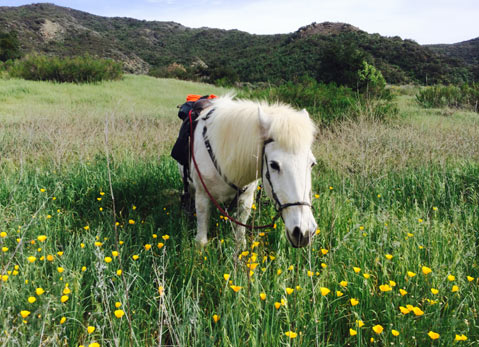Hero on Horseback
Celebrity Steed Rescues Two Dehydrated Runners in Dramatic Fashion

This year’s Santa Barbara 100-Mile Endurance Race saw a unique display of valiance in John Parke, a hero atop the back of steed Remington, whose deft riding through the Santa Ynez Mountains during the weekend of July 10 saved the lives of two race participants.
Parke, a regional director for the American Endurance Ride Conference (AERC), volunteered himself and his 27-year-old Icelandic pony as trail sweepers for their fifth consecutive race. He and Remington rode through parts of the trail with no vehicle access to ensure the runners made it safely through the course from where they set out on Friday at 6 p.m. to the finish, which they were expected to reach by 6 a.m. on Sunday.
Because of the course design, Parke said, most race participants hit the most rugged part of the trail at night. On Saturday at around 9:30 p.m., he and Remington encountered two severely dehydrated runners about 80 miles into the course. From atop Remington, Parke began to lead the runners to the nearest aid station, around five miles away. However, he soon realized runner #145 could not walk for more than 30 feet at a time, so he dismounted and helped the man onto Remington’s back in his place. According to Parke, an experienced horse like Remington can balance even an unsteady rider through uneven terrain. After about two hours of careful navigating, the rescue team arrived at the aid station.
Once runner #145 was in safe hands, Parke and Remington returned to sweep the last 20 miles of trail. The second scare happened at around 3 a.m. Sunday morning, mere hours before the race was set to conclude. Parke and Remington discovered a lone runner, #120, lying on the ground, cold and disoriented. After prodding him a bit, Parke discovered that he had been there for approximately three and a half hours. He had also begun hallucinating, and admitted he initially thought Remington to be an illusion.
Parke hoisted runner #120 atop Remington’s back, encouraging him to hold the mane for security. He then tented a space blanket over the runner and 800-pound horse, utilizing the hefty animal’s 101-degree body temperature to begin warming the man as the trio trekked another five miles to the nearest aid. By the time they made it, just before sunrise, the runner had become more coherent, according to Parke.
In four prior years trail sweeping for the race, Parke and Remington had never needed to rescue a runner—much less two—in such a dramatic fashion. According to Parke, it was the “first time that we had people that I felt needed to be carried out.” He admits it is unusual for an inexperienced rider to make such a journey with success, especially when the runner is already incapacitated in other ways. Parke credits this success to Remington’s sturdiness as an endurance horse, but also to his confidence, which “allows him to pretty much do anything,” Remington said. “It’s pretty amazing.”
The pair’s quick instincts have been bred by over two decades together, longer than any other endurance team competing in the AERC or even worldwide. Remington was elected to the AERC Hall of Fame in 2013 for his exceptional longevity endurance, especially in a sport that lends itself to lankier horses. He has ridden a total of 11,450 competitive endurance miles, one of the 10 highest mileage records in the world.
The goal of endurance riding is not only to complete the course in an optimal amount of time, but also to ensure that each horse finishes the race in a healthy condition. Veterinarians at various hold stops along a course decide whether a horse is “fit to continue,” and conduct post-race examinations to determine whether each team should get credit for completing the course. “It’s really difficult to sustain because it’s such an athletic sport,” said Candace Fitzgerald, a public relations representative for the AERC.
Fitzgerald describes Remington’s case as extraordinary in the world of endurance riding. The sport requires both horse and rider to navigate a course at least 50 miles long, usually through mountainous terrain with several drastic changes in altitude. The average career length of an endurance horse is 10-15 years, a far cry from Remington’s 20 years and counting. “You’d think he’s a My Little Pony toy, you know, but he’s tough,” Parke says. He describes Remington’s personality as “bossy” and “domineering;” though, he jokes, some may describe him the same way. Practically a member of the family, Remington once carried Parke’s youngest son to an endurance race finish as well.
Thanks to the duo’s heroism, both runners have since made a full recovery. Parke gives much of the credit to his trusted steed. “He will take care of people that need to be taken care of,” he said. “Those guys were lucky to have a horse like Remington out there.”



